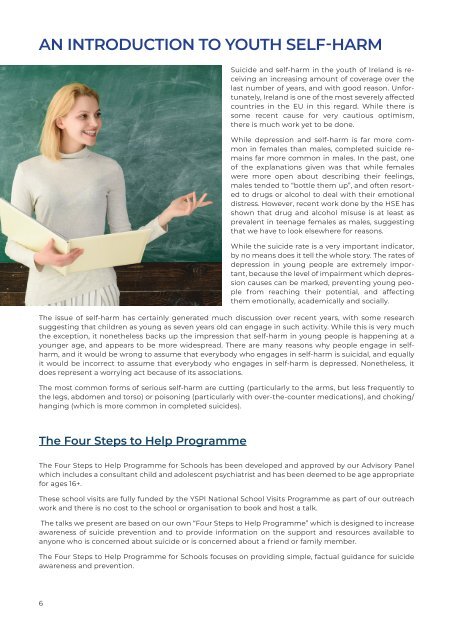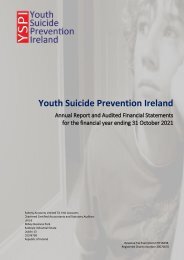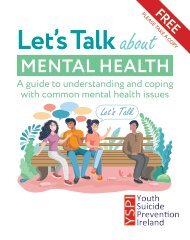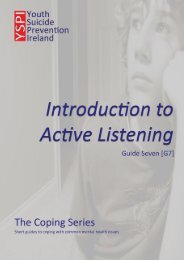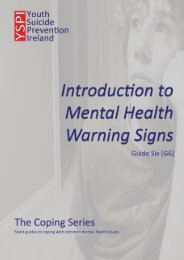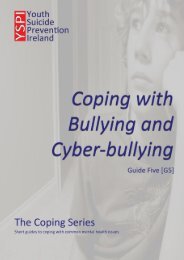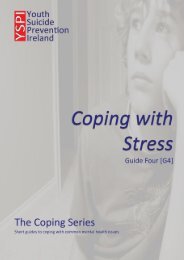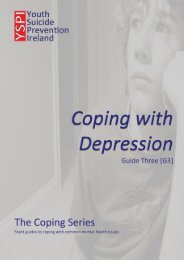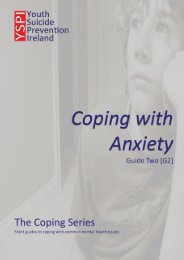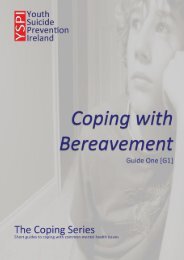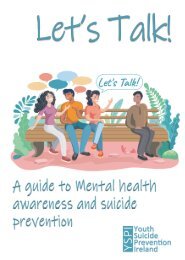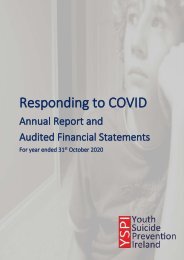Guidance and Information for Teachers and Lecturers
Teachers' guide to youth mental health and suicide prevention, now in it's 10th edition. Topics covered in this guide include: * Introduction to youth mental health awareness * Awareness of mental health risk factors * Recognising the symptoms of mental health issues * Helping someone with mental health issues * Understanding the dangers: Cyber-bullying Online Dangers Locked-away Syndrome * Supporting and developing coping strategies * Warnings signs of suicidal thoughts * Suicide Prevention and intervention * How to help and get help * Child Protection Policies
Teachers' guide to youth mental health and suicide prevention, now in it's 10th edition.
Topics covered in this guide include:
* Introduction to youth mental health awareness
* Awareness of mental health risk factors
* Recognising the symptoms of mental health issues
* Helping someone with mental health issues
* Understanding the dangers:
Cyber-bullying
Online Dangers
Locked-away Syndrome
* Supporting and developing coping strategies
* Warnings signs of suicidal thoughts
* Suicide Prevention and intervention
* How to help and get help
* Child Protection Policies
- No tags were found...
You also want an ePaper? Increase the reach of your titles
YUMPU automatically turns print PDFs into web optimized ePapers that Google loves.
AN INTRODUCTION TO YOUTH SELF-HARM<br />
Suicide <strong>and</strong> self-harm in the youth of Irel<strong>and</strong> is receiving<br />
an increasing amount of coverage over the<br />
last number of years, <strong>and</strong> with good reason. Un<strong>for</strong>tunately,<br />
Irel<strong>and</strong> is one of the most severely affected<br />
countries in the EU in this regard. While there is<br />
some recent cause <strong>for</strong> very cautious optimism,<br />
there is much work yet to be done.<br />
While depression <strong>and</strong> self-harm is far more common<br />
in females than males, completed suicide remains<br />
far more common in males. In the past, one<br />
of the explanations given was that while females<br />
were more open about describing their feelings,<br />
males tended to “bottle them up”, <strong>and</strong> often resorted<br />
to drugs or alcohol to deal with their emotional<br />
distress. However, recent work done by the HSE has<br />
shown that drug <strong>and</strong> alcohol misuse is at least as<br />
prevalent in teenage females as males, suggesting<br />
that we have to look elsewhere <strong>for</strong> reasons.<br />
While the suicide rate is a very important indicator,<br />
by no means does it tell the whole story. The rates of<br />
depression in young people are extremely important,<br />
because the level of impairment which depression<br />
causes can be marked, preventing young people<br />
from reaching their potential, <strong>and</strong> affecting<br />
them emotionally, academically <strong>and</strong> socially.<br />
The issue of self-harm has certainly generated much discussion over recent years, with some research<br />
suggesting that children as young as seven years old can engage in such activity. While this is very much<br />
the exception, it nonetheless backs up the impression that self-harm in young people is happening at a<br />
younger age, <strong>and</strong> appears to be more widespread. There are many reasons why people engage in selfharm,<br />
<strong>and</strong> it would be wrong to assume that everybody who engages in self-harm is suicidal, <strong>and</strong> equally<br />
it would be incorrect to assume that everybody who engages in self-harm is depressed. Nonetheless, it<br />
does represent a worrying act because of its associations.<br />
The most common <strong>for</strong>ms of serious self-harm are cutting (particularly to the arms, but less frequently to<br />
the legs, abdomen <strong>and</strong> torso) or poisoning (particularly with over-the-counter medications), <strong>and</strong> choking/<br />
hanging (which is more common in completed suicides).<br />
The Four Steps to Help Programme<br />
The Four Steps to Help Programme <strong>for</strong> Schools has been developed <strong>and</strong> approved by our Advisory Panel<br />
which includes a consultant child <strong>and</strong> adolescent psychiatrist <strong>and</strong> has been deemed to be age appropriate<br />
<strong>for</strong> ages 16+.<br />
These school visits are fully funded by the YSPI National School Visits Programme as part of our outreach<br />
work <strong>and</strong> there is no cost to the school or organisation to book <strong>and</strong> host a talk.<br />
The talks we present are based on our own “Four Steps to Help Programme” which is designed to increase<br />
awareness of suicide prevention <strong>and</strong> to provide in<strong>for</strong>mation on the support <strong>and</strong> resources available to<br />
anyone who is concerned about suicide or is concerned about a friend or family member.<br />
The Four Steps to Help Programme <strong>for</strong> Schools focuses on providing simple, factual guidance <strong>for</strong> suicide<br />
awareness <strong>and</strong> prevention.<br />
6


